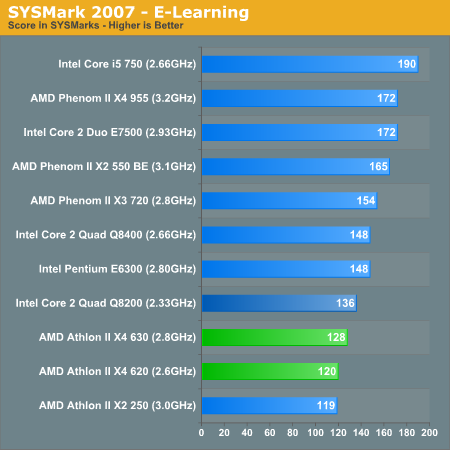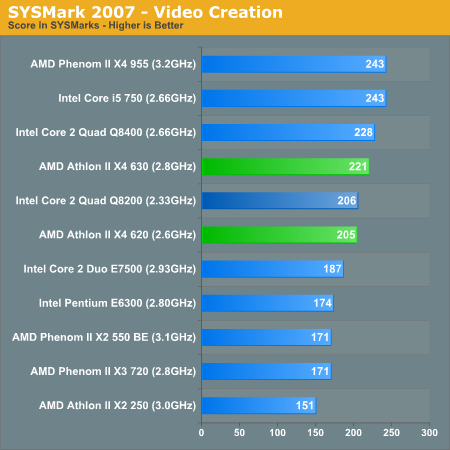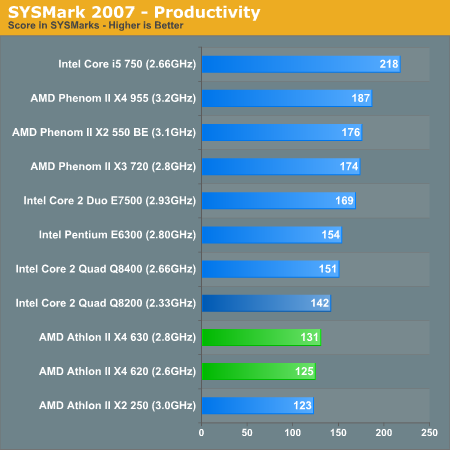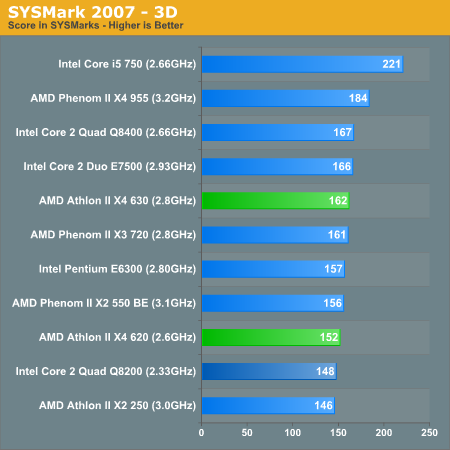AMD Athlon II X4 620 & 630: The First $99 Quad Core CPU
by Anand Lal Shimpi on September 16, 2009 12:00 AM EST- Posted in
- CPUs
SYSMark 2007 Performance
Our journey starts with SYSMark 2007, the only all-encompassing performance suite in our review today. The idea here is simple: one benchmark to indicate the overall performance of your machine.

If we only look at the AMD numbers in this chart, there's a pretty nice lineup going on here. The Athlon II X2 250 is slower than the Athlon II X4 620/630, which is slower than the Phenom II X3 730 and all are slower than the Phenom II X4 955. The performance lines up with the pricing, so all is good.
The problem with these cheap quad-cores has always been that you give up a lot in order to get four cores at a low price. The Athlon II X4 appears to break the mold however. The Athlon II X4 620 is priced at $99 and it performs like a $99 CPU. With the exception of the Core 2 Duo E7500 whose high clock speed makes it do unsually well here, the 620 is balanced. You get a reasonably high clock speed and enough cache to be competitive, both at a good price.
You'll see in the individual tests below that performance varies between competitive and underwhelming depending on the task. Anything that can take advantage of four cores does well, otherwise the smaller L2s of the Athlon II X4 hurt it a bit.

In applications that aren't well threaded, you'll see the Athlon II X4 perform less than stellar - but the same is true for all lower end quad-core CPUs. Even the Q8200 is outperformed by the E6300 here. Situations like this are validation for Intel's aggressive turbo modes on Lynnfield.

Any strenuous video encoding however will seriously favor the Athlon II X4. Here we find the $99 620 tying the Core 2 Quad Q8200, and the 630 outperforming it - all at a lower price.

We're back to needing higher clock speeds and larger caches to compete. Being a quad-core processor isn't easy.











150 Comments
View All Comments
Genx87 - Monday, September 21, 2009 - link
This losing battle for AMD has been going on since the introduction of the Core 2 Duo years ago. Where have you been?mdk77777 - Wednesday, September 16, 2009 - link
945 has been at $170 for weeks. That's a $55 difference from the price listed by ANAND :!: , it is also available at 95 watt :!:955 has been at or below $200
But that would conflict with the second coming of I5 at $210 so he conveniently ignores current pricing. :mrgreen:
Talk about bias, you write an article about pricing and market position and then ignore current pricing and market positions.
Pretty amazing.
Voo - Wednesday, September 16, 2009 - link
You do understand what the listed prices are, and just want to flame, right?mdk77777 - Wednesday, September 16, 2009 - link
How does AMD respond to Lynnfield? Is it by drastically cutting prices on Phenom II? Nope.Thats how the article starts. Correct, but they lowered prices weeks ago in anticipation.
A list price means nothing if it has been widely, significantly, and uniformly discounted.
Obviously they will update. Again, a story about market prices and market value of various CPU should reflect the market pricing.
yacoub - Wednesday, September 16, 2009 - link
you are correct that the actual prices are what matters -- after all, the entire point of this (and most if not all) article(s) here are for the benefit of people considering a purchase.Lolimaster - Thursday, September 17, 2009 - link
And then they talk about anand not being biased...PII 955 $189
PII 945 $169
Hey even in my country (Peru) wich has a lot of tech taxes the 955 costs less than AMD "official" price.
silverblue - Thursday, September 17, 2009 - link
Depending on which sites someone uses, they may not offer a better deal than another site they may be unaware of, likewise they could get a CPU for cheaper than you or I can. It's strictly relative in the end and doubtful to be the result of some sort of bias. Anand seems very impressed with the Propus and so too will be a lot of other people.Looking more closely at it, I believe it should perform closely with a similarly clocked (or overclocked?) Phenom I due to the lack of an L3 cache, though I couldn't say which would perform faster. Incidentally, I've been checking dabs.com and their most popular CPU is the Phenom X4 9650 at about £80; this is only 2.3GHz and is more expensive than the newly-launched Athlon II X4 620 by about £5, so it stands to reason that people will go for this one instead soon enough.
What I would really like to see, however, is a direct comparison between the 620 and the PII X4 905e (2.5GHz, 6MB L3) - it should be relatively simple to overclock one/downclock the other and see how much the lack of an L3 cache hurts the Athlon in a head-to-head, why the Athlon II X4's TDP is 95W whereas the 905e (with the 6MB L3 cache, remember) has a TDP of 65W, and whether it's worth the extra £50 for the 905e.
I did look at other CPU prices on this site as well as on a couple of others. The PII X4 955 and the i5-750 are roughly the same at about £150-£155 (though dabs.com has the 955 as £165 for some daft reason), whereas the PII X4 965 is closer to £180. It's very important to look around for the best price, however I'm starting to doubt the reason for the 965's existence now, at least until they cut its price.
mapesdhs - Thursday, September 17, 2009 - link
Indeed, shopping around is essential, and watchout for shipping
charges aswell.
After deciding what to buy, I Google for the part numbers or names
of the items I want, gather a selection of sites, see what can be
saved re shipping costs by buying multiple items from one seller.
I've ended up using a variety of companies over the years, sometimes
well known (Dabs, Scan, Microdirect), sometimes more obscure (Komplett,
C&C Central, Lambdatek, Overclockers, Tekheads). And doing it this
way means one has a better chance of locating special offers. I also
check on eBay for BIN offers from reputable sellers, which in one
case resulted in the best price for a PSU I wanted. The company names
above are in the UK, but the same applies anywhere.
Ian.
East17 - Thursday, September 17, 2009 - link
1. A benchmark should test the architecture clock for clock. Dynamic overclocking just messes things up even if it's on by default.Sure Turbo is a nice addition and sure it should have been available ever since dual core CPUs appeared just to prove customers that you're doing something about single thread performance too.
Turbo is a feature, not an architectural advantage. It's like saying a mainboard with Quad GigabutLAN on P45 is more performant than a Dual LAN on X58 just because it has this feature of having four LAN ports. Sure, if you do a LAN performance test you could find many ways in which you could show that the mainboard with Quad LAN is faster but surely you couldn't argue that P45 is superior to X58.
Anyway ... the testing shoul have been done with Turbo on and Turbo off to clearly show thr difference .
2.Deneb is 252% of Propus (300mln -> 758 transistors) but only offers around 10% performance improvement... Could you justify making the die size so much bigger just for 10%? Besides, if we talk about profit, if 252% = 225$ (Phenom 3GHz) and 100% = 99$ (Athlon II X4) ... Propus seems more profitable .
carniver - Wednesday, September 16, 2009 - link
Athlon: Emergency Edition